
MPC took over 007’s fiery showdown at Skyfall, with a helicopter crashlanding, night chase over the moors and 360° highlands environment.
SKYFALL RENDEZVOUS |
| ‘Skyfall’, the 23rd film in the James Bond series of thrillers, is Director Sam Mendes’ first action film. He used visual effects not only to add thrills and danger in the classic 007 style but stylistically as well. MPC’s VFX Supervisor Arundi Asregadoo described the way the effects their team created helped build suspense, establish continuity and create exciting cutting devices between sequences to weave the story together. They delivered more than 300 VFX shots. |
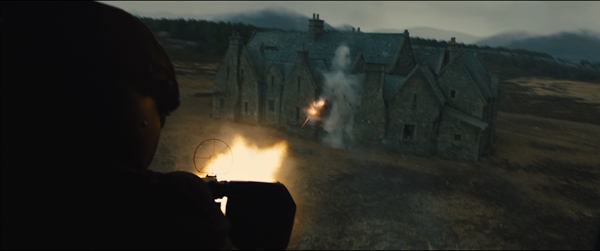 |
|
Steve Begg, overall VFX supervisor for Skyfall, approached MPC in 2011 during pre-production. The VFX team was awarded the climactic ending sequences when Bond and M travel together in the famous Aston Martin DB5 to Scotland, where the loose ends of the story come together and the audience learns the significance of ‘Skyfall’. Their work covers the Scottish mountain environment around Skyfall, the crash landing of a CG helicopter, a foot chase over a frozen lake, explosions and effects, and various set extensions Scottish HighlandsThe crew did not begin shooting the scenes until February 2012. The live action was captured at Hankley Common south of London, and at Pinewood and Longcross Studios, but not in Scotland. MPC’s first task was to build the cold isolated Scottish Highlands environment where Bond spent his childhood. In-house photographer James Kelly travelled up for a week long location shoot capturing panoramas of mountain scenery in the Glengorm Mountains in Scotland. He shot quantities of images to use as the team's reference and as the basis of their 360° 3D scene, forming a sequence of tiles. Within each stitch would be up to about 100 images, each at 5K resolution. At Hankley Common, MPC surveyed the whole set area to generate data used to re-create it as a 3D scene as well. This scene was combined with a very low resolution layout of cards representing positions of mountains and surrounding features, and imagery from the stitched panorama was then projected onto these cards. |
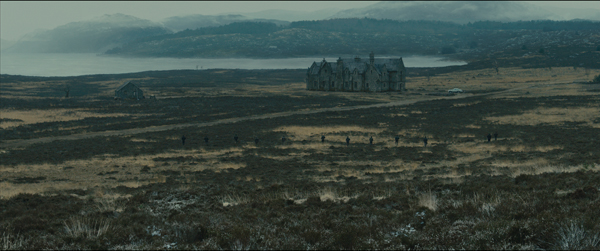 |
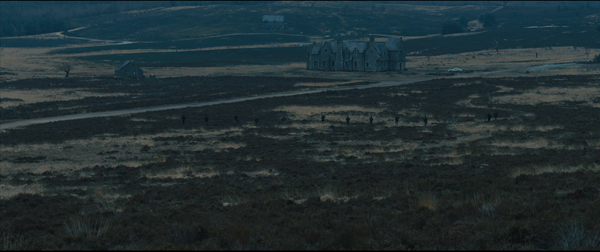 |
|
All together, it served as a rough but more or less complete layout model of the scene that Sam could consider. Once he gained an understanding of the relative size of the area the action would occupy compared to the mountains and other background elements he could adjust those sizes, decide where the key locations – the lodge, the lake and so on – should be and ultimately design the final looks and layout. The resulting high-resolution 360° cyclorama could then be composited with the edited live action photography. MPC’s 3D build gave Sam a lot of control over the set, and each time he saw it he could continue adjusting the position of the mountains and backgrounds while maintaining his overall geography – that is, tweaking to give each shot the right feeling. Environmental Precision“Steve Begg himself has a background as a digital matte painting artist and therefore wanted to keep a level of control over how the landscape should look and feel. So this flexible approach gave Steve, Sam and the editor Stuart Baird a chance to design the shots and scene quite precisely," said Arundi. "For example, on one shot, we laid out and designed all the mountains, added snow and layered in the hanging clouds, haze and mist to use as a key shot. “In fact, the Stuart Baird wound up editing this shot out of the sequence but when Steve and Sam saw it later, they fell in love with it and put it back into the movie. Thus it was an on-going process over time, shot by shot, to make the whole sequence look great.” |
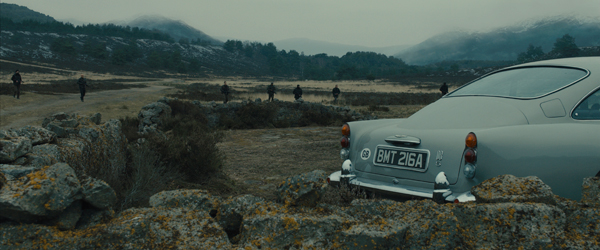 |
|
Because the daylight live action scene was shot outdoors without green screens and in sunshine, the artists generally needed to grey out the sunlight and remove shadows to give a bleak winter feeling. Sometimes a white screen was used to hide equipment on set interfering with the shoot, but more often they relied on a lot of rotoscoping to clean up the shots. They used Silhouette for this work. The goal was to achieve as natural a look in the plate as possible, without having to light the set artificially very much, as often happens with a green screen. What helped them do this was the fact that the landscape in the foreground didn’t extend high enough to interfere with the actor’s hair, and the skies tended to be quite flat - all of which were easier to rotoscope or key. All interior daylight shots at the lodge were shot on a stage set with white screens placed outside the windows to allow a natural feeling of daylight shining into the set. MPC supplied the environments outdoors, blending in and rotoscoping foreground people and environmental elements, again relying on the 360° cyclorama to determine what would be seen through each window. “The cyclorama was useful throughout this part of the film and worth putting together accurately early on. It not only helped avoid starting such shots from scratch. It also helped Sam and Roger understand how finished shots were going to look before shooting, and in any case we had about 200 environment shots to complete," Arundi said. |
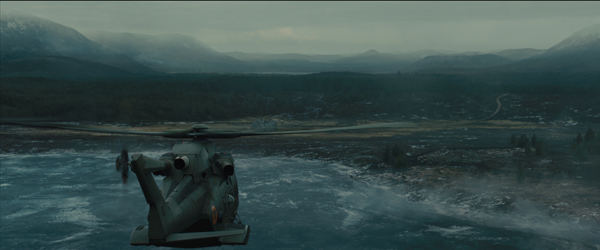 |
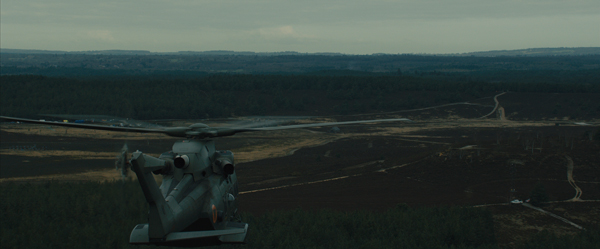 |
Landscape DressingIsabelle Rouselle and Jerome Martinez, lead artists in the Environment and DMP team, oversaw the set dressing, all done by hand, including gathering quantities of reference material and ensuring the snowline was at a consistent level. They made paintings from photographed images and combined this with reference from Hankley Common itself. The foreground trees were built and much of the work involved augmenting and manipulating the existing landscape to establish a foreground, midground and background. Mist and hanging cloud were elements extracted from different sources – smoke shot on black could be slowed to give the right look, which also relied on the way they were pulled together in the composite. Once they had all passes from the digital matte paintings and environments the compositors then had to control how much hazing went into a shot, how much the clouds would move and so on. Snow was a look they could dial in by adjusting layers of different densities. The nature of MPC’s work in ‘Skyfall’ meant that compositing had a large effect on looks. All work was done in Nuke, extended with internally created tools. The composting supervisor was Matt Packham and the lead compositor would vary, per sequence. Martin Riedel led for the daytime look, David Griffin handled the Merlin attack on the lodge and Brad Floyd was lead compositor for the chase across the moor and underwater. Miniature ShootSteve Begg’s intentions for the Merlin helicopter crash were to stage and capture it as a miniature shoot. Steve and Chris Corbould, working both as a 2nd unit director and miniature effects supervisor, organised the build of one-third scale miniatures of the Skyfall lodge and the helicopter at Longcross Studios in Surry, south of London. |
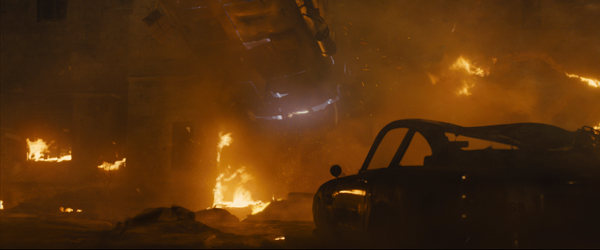 |
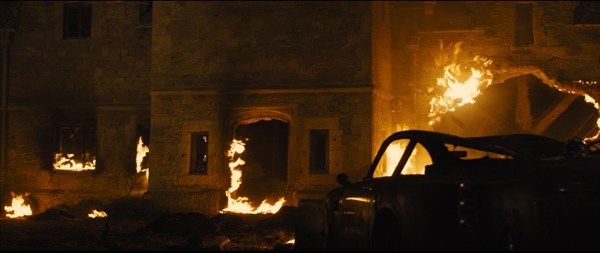 |
|
All shots and scenes for the sequence are based on this miniature shoot, which Arundi estimates accounts for about 50 per cent of what is seen in the film. It also includes a miniature of the DB5. To be able to perfect the looks of this footage in which the helicopter, car and lodge explode, three copies each of both the helicopter and the car were built, and the lodge was made in a way allowing it to be built up again for each shoot Once MPC had the photography, there were specific issues to address. The rig controlling the miniature was limited in the angle at which it could hold the helicopter and its acceleration as it crashed into the lodge. To make it work in the shots as Sam wanted, MPC built a CG helicopter to replace the Merlin, and reanimated all helicopters within the scene. A partial projection from the plate was also made to preserve the interactive lighting from the exploding lodge to use on the digital helicopter. The CG blades were added, plus all of the associated atmospheric downdraft, achieved through digital simulations. Time and ScaleWhat was important for the artists to be aware of in this case was the way the edit was working. The editor was responsible for making a high action sequence shot in two different places at two different scales look as though it was all happening together, at once. MPC contributed by enhancing and augmenting the photography shot at both locations. They developed a good working relationship with the editors, going back and forth on shots that needed to cut together well. |
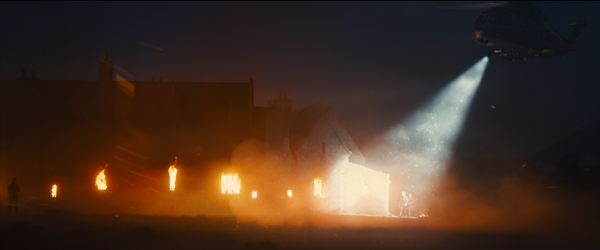 |
|
The different scales of the fire were an issue, addressed by adding more 2D fire to the live action shots. Levels of mist, fog and smoke, and the quantities of debris blowing around, all had to match to visually tie the scenes together. Arundi pointed out that in true 007 spirit, the explosions seen in the film both on the miniature set and on Hankley Common, are quite real although enhanced with flames and debris. Fortunately, the shot of the actual impact of the helicopter flying into the house, when the viewer sees the undercarriage passing by, is all full CG, which gave MPC control over all looks. “The body had to rip apart as a Merlin would, not fall apart and break. As a troop carrier, it was built to be very tough and sturdy so that the inner structure held together well while the exterior simply split apart. We built it to break up in this particular way and added internal explosions,” said Arundi. “We watched footage of different types of helicopters crashing - traumatic in itself knowing that there were people inside them - comparing the way the heavier and lighter aircraft behaved. As soon as the propeller blades break or are damaged in any way, it affects the movements of the main body immediately." Perfect DestructionThe team built the CG model of the Merlin in Maya, MPC’s front-end 3D tool with a number of custom tools bolted onto it. The art department supplied them with CAD files of the helicopter’s construction, which were given to them by August Westland. |
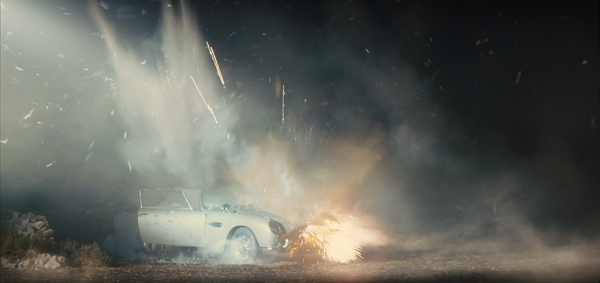 |
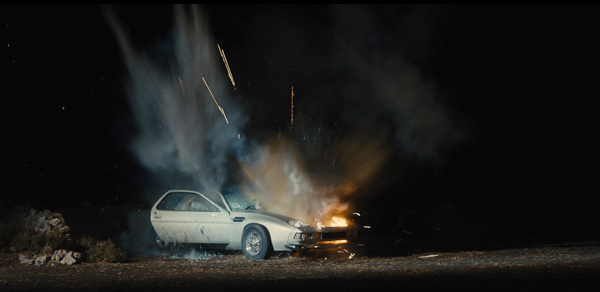 |
|
“When we built the front of it smashing into the lodge we also built out the front of the building in CG using our destruction software, Kali," Arundi said. "When the rotor blades hit the stone work and started to slice the front of the building, Kali gave us control over how the debris fell, how far it pitched, how the stone should crumble and so on. All of this combined destruction helped generate the debris and smoke that came off the wreck, which would also be affected by the rotation of the blades. We researched how the materials and objects should behave.” Nevertheless, the looks resulting from Kali, which simply works in a physically correct way, may still not hit the mark in terms of the story, the rest of the sequence and movie – or the director. In this case they had to break the rules and change the parameters here and there to create the right aesthetics. Certain portions were retimed or sped up, for example. Aston Martin DB5The helicopter and lodge were not the only casualties of the explosions and gunfire at Skyfall. MPC also took over the destruction of Bond’s beautiful DB5 as well. They had access to a pristine, undamaged DB5 and two burned out wrecks. Live action plates were captured of the DB5 in position on set, but for such damage as the windscreen breaking and cracking, Steve Begg had extra windscreens, lights and headlamps built. For a particular shot that takes a 180° sweep around the car, a green screen version of the front and windscreen was built. They embedded small explosive squibs along its length to represent bullet hits. This arrangement was shot with motion control to produce elements working for that particular shot and camera move. Separate elements were also shot for all the bullet hits and cracking glass. Once they had this collection of variations they combined and re-projected them. Their first pass was made onto a working CG model serving as a layout composite to work out the hit locations and how much could be seen in which shots. Then, once Sam liked the looks, they would continue to finalise each shot. |
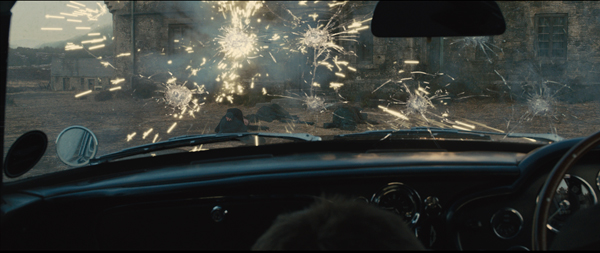 |
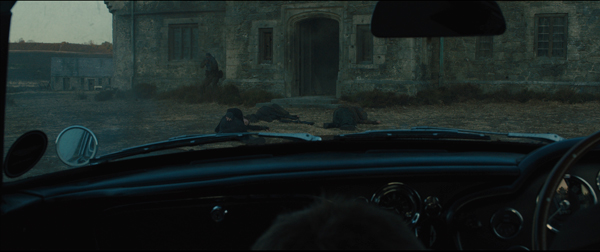 |
|
More research into metal behaviour and cracking glass followed to find out what bullet proof DB5s look like when riddled with bullets. Arundi assures viewers that instead of destroying the clean car on set, two damaged cars were employed, one for each of two waves of attack. In the first it is riddled by bullets, and in the second the Merlin hits it and blows it up. “For this second wave, Steve brought in a stand-in vehicle of the same shape and size as the DB5 to explode on set," said Arundi. "Once we had those explosion shots back in the studio we combined them with the shots of the clean car sitting in the same place and proceeded with the extra, projected damage, plus flames, smoke, and exploding broken glass. So really it was just clever use of 2D tricks, adding diverse damage elements via 3D projection, although having that accurate 3D model was critical and gave us a lot of control and flexibility over the fire damage to the metal." Light MatrixThe live action camera crew and actors shifted to a darkened set at Longcross Studios to shoot the villain Silva’s final pursuit of M across the moor after the explosions. MPC’s task was to make the studio set appear and feel the same as the shoot on Hankley Common – but without the burning lodge. To create it in the shots, they had to take elements from that fire and combine these with shots of the miniature lodge, adding a damaged CG roof. “Roger Deakins built a large glowing light matrix and set this up in the background to effectively simulate the look of firelight behind the action. We had to remove his light set-up later from the shots, but it produced a wide source of natural looking interactive lighting on the actors, which would have been very difficult to recreate in post," explained Arundi. |
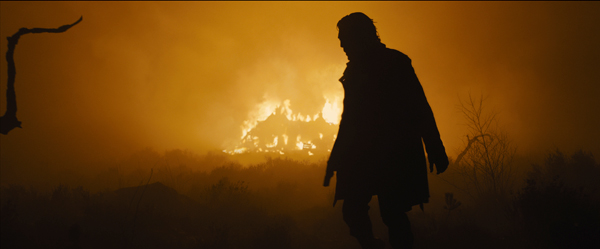 |
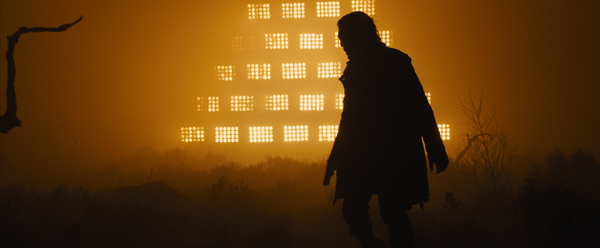 |
|
“The scene was shot on a black stage, which was also helpful and was made possible by the ARRI ALEXA camera Roger was using, which gave the images a lot of latitude and allowed him to record extra detail in the blacks. We could still rotoscope the characters in spite of the dark conditions and gave Roger a chance to use natural light. The same image on film wouldn’t have let us see enough detail in the low light regions. There were no green screens, no artificial highlights on characters, and it was easy to pull elements out. Mapping the Set“The studio footage was clean, of course, and we had to add all the atmosphere, hanging mist over the ground and fire smoke in the sky. We also extended out the ice lake. On set, they had built only a small portion of the ground the actors run on and of the ice 007 walks across, and so we extended all of this to include the mound Silva stands on.” Because the set was relatively small they had to work out with Sam how to accurately distance M from the burning house, how far Silva was from M and so forth, none of which existed in the studio space. They returned to their 360° cyclorama to create the characters’ point-of-view shots, the location of the lake relative to the house and ensure all directional clues added up to a realistic, complete environment. It took the team a while to find their feet. After the initial blocking, the sequence still felt as though it was in a set and the location of each character felt undefined. Frozen breath was a story point, indicating the exertion the characters were feeling as they ran over the chill, dark moor. Varied 2D elements were composited into shots in layers and retimed, including imagery from dry ice to steam from boiling kettles. |
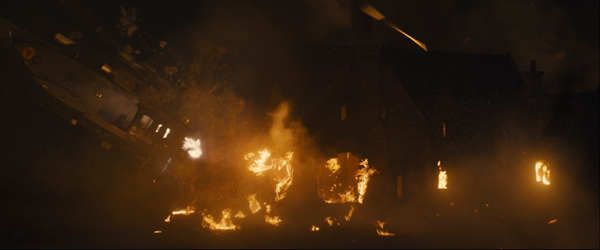 |
|
Back at Pinewood Studios, the underwater fights in the frozen lake were shot on green and black screens. The ice surface was created digitally by projecting textures onto a flat surface and then combining them in the composite. Some element shots of bubbles and particulates in water were added as well. The production’s built section served as an initial guide to how the cracked ice surface of the lake should look, and they went on to look at frozen lake reference to decide on the looks from underneath. Red LakeThe colour scheme came from the DP, who wanted to use red. “The red from the fire was so strong in the images on land that he wanted to see it continued below, but it was purely a stylistic choice,” Arundi said. “The frequency of red doesn’t travel far underwater and it would have quickly turned murky blue green. But Roger wanted to allow the editor to make rapid cuts from above to below the surface without confusing the audience. "For MPC’s part, we employed a flatter heavily textured look on the ice overhead instead of the layering of an ancient lake, to give the scene a fresher look. The team was always trying to work with Roger’s composition style. He follows classical composition in his work with clean graphic lines, and we aimed to maintain that look whenever we had to re-create plates. “We had a couple of DI sessions with him also as the grading started on the sequence to look for continuity points like the helicopter downdraft or positions of firelight missing in the photography. When we were designing the mountain scenery he pointed out what he liked – hanging clouds, for example – so we would try to add more.” After the underwater fight Bond searches for a point of escape from under the ice and the audience wonders if he will drown or survive. He lets loose a flare for which MPC created a specific bubble simulation representing the flare travelling away from. However instead of the flare’s exponential glow diminishing as it travels away, Sam chose to use it as a cutting device in the edit. The flare actually increases in intensity, in the end whiting out the frame and closing off the sequence. Sam wanted to keep the audience guessing, and give himself a chance to decide exactly what should happen next. www.moving-picture.com Words: Adriene Hurst |


















